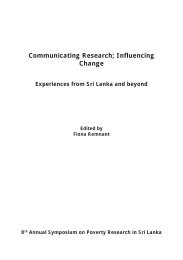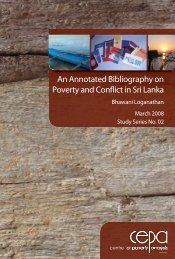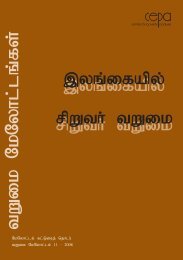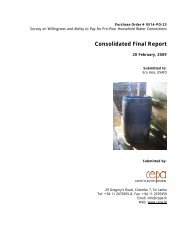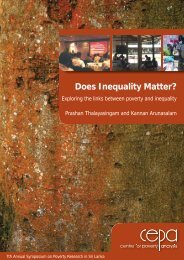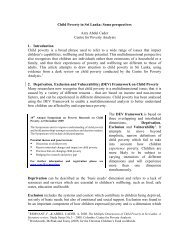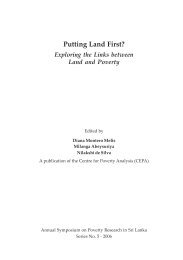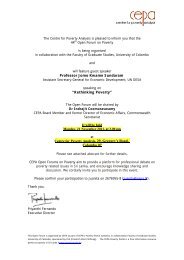Involuntary Displacement and Resettlement â Policy and ... - CEPA
Involuntary Displacement and Resettlement â Policy and ... - CEPA
Involuntary Displacement and Resettlement â Policy and ... - CEPA
- No tags were found...
You also want an ePaper? Increase the reach of your titles
YUMPU automatically turns print PDFs into web optimized ePapers that Google loves.
coined the term ‘sustainable livelihoods’, which is a key concept of thepresent day poverty debate. Though DFID’s sustainable livelihoodsframework is often applied to refugee <strong>and</strong> IDP livelihoods, Jacobsen (2002:98) argues that it is useful mainly to analyse poverty reduction in stablesituations. Displaced people <strong>and</strong> refugees, in contrast, seek livelihoods insituations which are far from stable. Therefore, this paper uses Jacobsen’s(2002: 99) definition of a livelihood, which is more relevant for situations ofCID:In communities facing conflict <strong>and</strong> displacement, livelihoods comprise howpeople access <strong>and</strong> mobilize resources enabling them to increase theireconomic security, thereby reducing the vulnerability created <strong>and</strong> exacerbatedby conflict, <strong>and</strong> how they pursue goals necessary for survival <strong>and</strong>possible return.The critical terms <strong>and</strong> phrases in this definition, according to ourassessment, are ‘vulnerability’, ‘conflict’, ‘survival’, <strong>and</strong> ‘return’. Together,they clearly delineate this definition from that of Chambers <strong>and</strong> Conway(1992: i), which, we agree, is more useful to analyse DID livelihoods. Thethread of the argument, which attempts to highlight the subtle but importantdistinctions between CID livelihoods <strong>and</strong> DID livelihoods, will run throughoutthis paper. These distinctions are not easy to detect because both CID <strong>and</strong>DID occur under quite similar push factors: “a combination of violatedhuman rights <strong>and</strong> anticipation of ‘human security’ in other regions” (Muggah2000: 198).The main constraint in doing microeconomic analysis in conflict affectedregions is the lack of data (Närman <strong>and</strong> Vidanapathirana 2005: 14). Forinstance, Mutur DS division, which includes the village of Sampur, was noteven included in the 2001 census because several villages within Mutur DSdivision were under LTTE control at that time (Bohle <strong>and</strong> Fünfgeld 2007:672). Thus, to our knowledge, no secondary data is available for the regionwe explore in this study, <strong>and</strong> to perform any kind of economic analysis, onehas to rely on primary data. In that regard Bohle <strong>and</strong> Fünfgeld highlightanother problem: the “need for protecting the security of researchparticipants.” This is because the Batticaloa district where we did field workwas at that time a highly volatile <strong>and</strong> dangerous location. In fact securityconcerns forced us to divide our data collection process into two periods.59



